|
|
|
Sort Order |
|
|
|
Items / Page
|
|
|
|
|
|
|
| Srl | Item |
| 1 |
ID:
189552
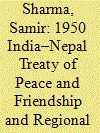

|
|
|
|
|
| Summary/Abstract |
Regional demands for statehood in India have had an aspiration towards a ‘nationalisation’ of their issues in the hopes of accommodation. In the case of the Gorkhaland movement for separate statehood in northern West Bengal, the competition among regional forces to occupy and share a ‘national political space’ from the ‘margins’ has fuelled the increasing employment of debates regarding international treaty obligations. While there are numerous factors that are the causes of regional political mobilisation, the demand for the abrogation of Article VII of the India–Nepal Treaty of Peace and Friendship (1950) has nevertheless remained as one of its central themes. This symbolises an accentuation in the anxieties of citizenship and belonging to the nation. Examining these amid the important issues relating to unsuccessful invocations from Nepal for a Brihat Nepal (Greater Nepal), and the constitution of the Eminent Persons Group (EPG) for India–Nepal relations, the article concludes that there will not be any radical change in the status quo of India’s international treaty obligations with Nepal despite repeated demands by regional actors in India. This is indicated in an elusive ‘permanent political solution’ declared by the ruling party in India as a response to the regional political mobilisation that will possibly depart from the debates that invoke and demand transformations to India’s treaty obligations with Nepal.
|
|
|
|
|
|
|
|
|
|
|
|
|
|
|
|
| 2 |
ID:
189549
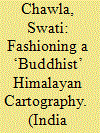

|
|
|
|
|
| Summary/Abstract |
In the months leading up to the transfer of power in India, the eastern Himalayan kingdom of Sikkim made several representations to the Cabinet Mission and other constitutional bodies that were giving shape to the successor Indian government. The Sikkim Darbar was worried that its ambiguous position under colonial treaties might lead India to treat it as one of the five-hundred odd princely states that were slowly merging with the union. In letters, memoranda, legal briefs, and personal meetings, the Darbar argued that it was racially, religiously, socially, and culturally distinct from India, and that its allegiance lied to its north with Tibet. This article traces the vocabulary for the Sikkim Darbar’s assertion of difference from India back to the racialised imperial writing and realpolitik that had informed colonial policy towards the Himalayan states since the nineteenth century, most notably Olaf Caroe’s 1940 thesis on the ‘Mongolian Fringe’. This archival evidence emphasises Sikkimese agency and helps excavate an imagination of the Himalaya from within the region. The article also nuances the history of the forging of Indian republic by foregrounding the processes of negotiation and compromise that continued to shape the territorial contours of the Indian nation long after the moment of decolonisation.
|
|
|
|
|
|
|
|
|
|
|
|
|
|
|
|
| 3 |
ID:
189548
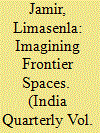

|
|
|
|
|
| Summary/Abstract |
This article concerns the northeast frontier of British India during the last years of British rule. It explores how the conundrums of the Second World War led to the reconfiguration of the northeast frontier as a strategic space in the empire’s geopolitics. This reconfiguration was pushed by contestation over the frontier spaces by different powers—threatened by the Japanese during the Second World War and, later, the possible post-war reification of Chinese and Tibetan expansionist policy towards India’s northeast frontier and the impending Indian independence. The colonial state’s strategic interest led the frontier officials to reimagine the northeast frontier, whereby the region and its local populations came to be regarded as integral to the preservation of the colonial state’s dominance.
|
|
|
|
|
|
|
|
|
|
|
|
|
|
|
|
| 4 |
ID:
189550
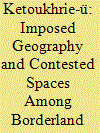

|
|
|
|
|
| Summary/Abstract |
Imposed geography in the form of cartographic mapping and boundary lines is part of the state-making and production of ‘legible’ subjects throughout the world. As a result of such impositions, there have been constant claims and contestations of space, nation and citizenship among the borderland communities. Such claims and contestations have sustained and reinforced connections and mobility of the borderland communities across the border. Such cross-border connections and mobility are found very commonly even among the borderland communities of Northeast India. With huge borderlands, Northeast India has diverse borderland communities that maintain close ethnic ties across artificial and imposed boundaries. Based on fieldwork conducted both in India and Myanmar, the present article centres on the Konyak Nagas and Khiamniungan Nagas living on both sides of the Indo-Myanmar boundary and looks at how these borderland communities constantly negotiate with the imposed border and sustain their relationship across the border. The article delves into the question of how such imposed geography has resulted in the contestation of space, nation and citizenship among the borderland communities which points toward new layers of complicacy defying the very rationale of a hard border.
|
|
|
|
|
|
|
|
|
|
|
|
|
|
|
|
| 5 |
ID:
189554
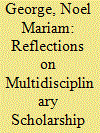

|
|
|
|
|
| Summary/Abstract |
Early mapping of Himalayan frontiers, were intimately tied to the imperial conquest of space. Polycentric contestations of the British, Russian, Qing and even Tibetan expansionist imaginaries dominated such territorial endeavours. In the mid-twentieth century, in the switch from empire to nation, scholarship on borders and borderlands reinforced methodological nationalism in spaces with multiple sovereignty and overlapping treaties. While early post-colonial scholarship critiqued the colonial construction of borders, there have been efforts to tease out newer ways of narrating borders that take cognisance of the continuing heterarchies of violence in the modern nation. Such scholarly ‘decolonial’ endeavours have challenged the overwhelming emphasis on state and territoriality in colonial and later national accounts on borders. By imagining the Himalayan transregional frontier as central, rather than peripheral to state making, these notes challenge the cultivation of the Himalayas as culturally, even civilisationally ‘primitive’. Conceptualising the borderland as an epistemic category, these survey notes synthesise more recent decolonial scholarship on Himalayan borders and borderlands to sketch out emerging geographies of (im)mobility, militarisation and violence.
|
|
|
|
|
|
|
|
|
|
|
|
|
|
|
|
| 6 |
ID:
189551
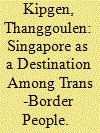

|
|
|
|
|
| Summary/Abstract |
This article analyses the significance of kinship and ethnic networks in the migration of the Kuki people from the Indo-Myanmar borderland to Singapore. In addition to facilitating the dissemination of information and the formation of collective decisions, kinship and ethnic networks are crucial in fostering a sense of community and belonging in the new destination. The article investigates the church’s function among Singapore’s Kuki population. It argues that religion deconstructs ‘otherness’ that came about when colonial rulers split the Kukis into two separate countries (India and Myanmar). The church serves as a powerful symbol of Kuki identity since it facilitates efforts for ethnic unification and allows them to revive the sense of ethnic solidarity lost for decades.
|
|
|
|
|
|
|
|
|
|
|
|
|
|
|
|
| 7 |
ID:
189553


|
|
|
|
|
| Summary/Abstract |
Based on an ethnographic study of former Bangladeshi enclaves in India, the article explores how the India–Bangladesh border is negotiated and reproduced in the everyday spaces of people living in the borderland that is often overlooked by the usual representation of geopolitical nationalism and hard realities of the barbed wire. Enclaves are fragmented territories surrounded by another state, such as Bangladeshi enclaves surrounded by Indian land and vice versa. Being abandoned by the home state, the former enclave residents were deprived of identity documents, and as a result, precluded from judicial and citizenship rights. The article focuses on marriage-related migration of women that was often used as a way out to overcome the vulnerabilities associated with living in the enclaves. Marriage proposal inside the host country promises access to public goods like a ‘Ration Card’, or identity documents like an ‘Aadhaar card’, thus determining the possible migration of women—their life paths and destinations across the enclaves and the host country. The latitudes of such migratory life courses of women along the border are determined by their religion and economic status. The study shows that these practices, although often necessary for survival, subsequently compromise the agency of the women in the process.
|
|
|
|
|
|
|
|
|
|
|
|
|
|
|
|
|
|
|
|
|